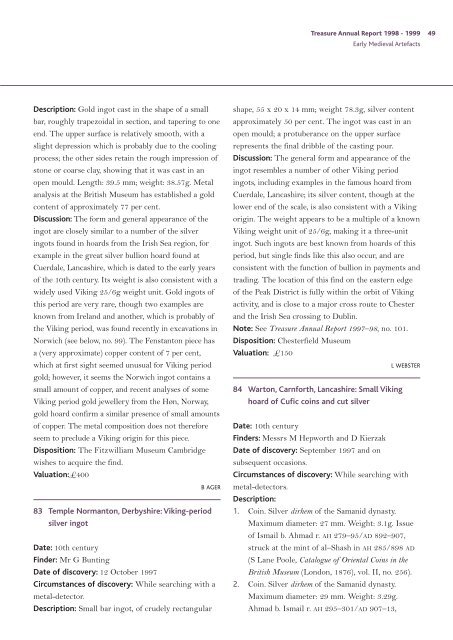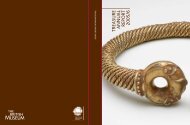Treasure Annual Report 1998-1999 - Portable Antiquities Scheme
Treasure Annual Report 1998-1999 - Portable Antiquities Scheme
Treasure Annual Report 1998-1999 - Portable Antiquities Scheme
You also want an ePaper? Increase the reach of your titles
YUMPU automatically turns print PDFs into web optimized ePapers that Google loves.
Description: Gold ingot cast in the shape of a small<br />
bar, roughly trapezoidal in section, and tapering to one<br />
end. The upper surface is relatively smooth, with a<br />
slight depression which is probably due to the cooling<br />
process; the other sides retain the rough impression of<br />
stone or coarse clay, showing that it was cast in an<br />
open mould. Length: 39.5 mm; weight: 38.57g. Metal<br />
analysis at the British Museum has established a gold<br />
content of approximately 77 per cent.<br />
Discussion: The form and general appearance of the<br />
ingot are closely similar to a number of the silver<br />
ingots found in hoards from the Irish Sea region, for<br />
example in the great silver bullion hoard found at<br />
Cuerdale, Lancashire, which is dated to the early years<br />
of the 10th century. Its weight is also consistent with a<br />
widely used Viking 25/6g weight unit. Gold ingots of<br />
this period are very rare, though two examples are<br />
known from Ireland and another, which is probably of<br />
the Viking period, was found recently in excavations in<br />
Norwich (see below, no. 99). The Fenstanton piece has<br />
a (very approximate) copper content of 7 per cent,<br />
which at first sight seemed unusual for Viking period<br />
gold; however, it seems the Norwich ingot contains a<br />
small amount of copper, and recent analyses of some<br />
Viking period gold jewellery from the Høn, Norway,<br />
gold hoard confirm a similar presence of small amounts<br />
of copper. The metal composition does not therefore<br />
seem to preclude a Viking origin for this piece.<br />
Disposition: The Fitzwilliam Museum Cambridge<br />
wishes to acquire the find.<br />
Valuation:£400<br />
B AGER<br />
83 Temple Normanton, Derbyshire: Viking-period<br />
silver ingot<br />
Date: 10th century<br />
Finder: Mr G Bunting<br />
Date of discovery: 12 October 1997<br />
Circumstances of discovery: While searching with a<br />
metal-detector.<br />
Description: Small bar ingot, of crudely rectangular<br />
<strong>Treasure</strong> <strong>Annual</strong> <strong>Report</strong> <strong>1998</strong> - <strong>1999</strong> 49<br />
Early Medieval Artefacts<br />
shape, 55 x 20 x 14 mm; weight 78.3g, silver content<br />
approximately 50 per cent. The ingot was cast in an<br />
open mould; a protuberance on the upper surface<br />
represents the final dribble of the casting pour.<br />
Discussion: The general form and appearance of the<br />
ingot resembles a number of other Viking period<br />
ingots, including examples in the famous hoard from<br />
Cuerdale, Lancashire; its silver content, though at the<br />
lower end of the scale, is also consistent with a Viking<br />
origin. The weight appears to be a multiple of a known<br />
Viking weight unit of 25/6g, making it a three-unit<br />
ingot. Such ingots are best known from hoards of this<br />
period, but single finds like this also occur, and are<br />
consistent with the function of bullion in payments and<br />
trading. The location of this find on the eastern edge<br />
of the Peak District is fully within the orbit of Viking<br />
activity, and is close to a major cross route to Chester<br />
and the Irish Sea crossing to Dublin.<br />
Note: See <strong>Treasure</strong> <strong>Annual</strong> <strong>Report</strong> 1997–98, no. 101.<br />
Disposition: Chesterfield Museum<br />
Valuation: £150<br />
84 Warton, Carnforth, Lancashire: Small Viking<br />
hoard of Cufic coins and cut silver<br />
L WEBSTER<br />
Date: 10th century<br />
Finders: Messrs M Hepworth and D Kierzak<br />
Date of discovery: September 1997 and on<br />
subsequent occasions.<br />
Circumstances of discovery: While searching with<br />
metal-detectors.<br />
Description:<br />
1. Coin. Silver dirhem of the Samanid dynasty.<br />
Maximum diameter: 27 mm. Weight: 3.1g. Issue<br />
of Ismail b. Ahmad r. AH 279–95/AD 892–907,<br />
struck at the mint of al–Shash in AH 285/898 AD<br />
(S Lane Poole, Catalogue of Oriental Coins in the<br />
British Museum (London, 1876), vol. II, no. 256).<br />
2. Coin. Silver dirhem of the Samanid dynasty.<br />
Maximum diameter: 29 mm. Weight: 3.29g.<br />
Ahmad b. Ismail r. AH 295–301/AD 907–13,





